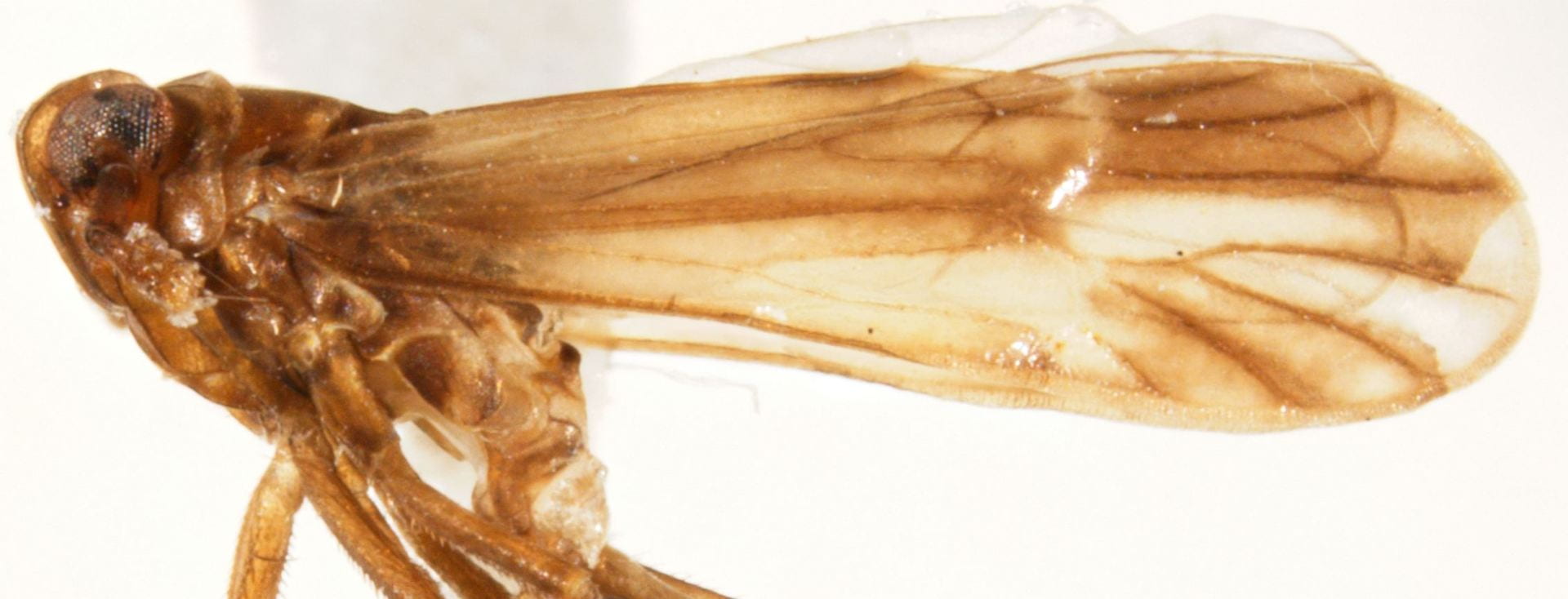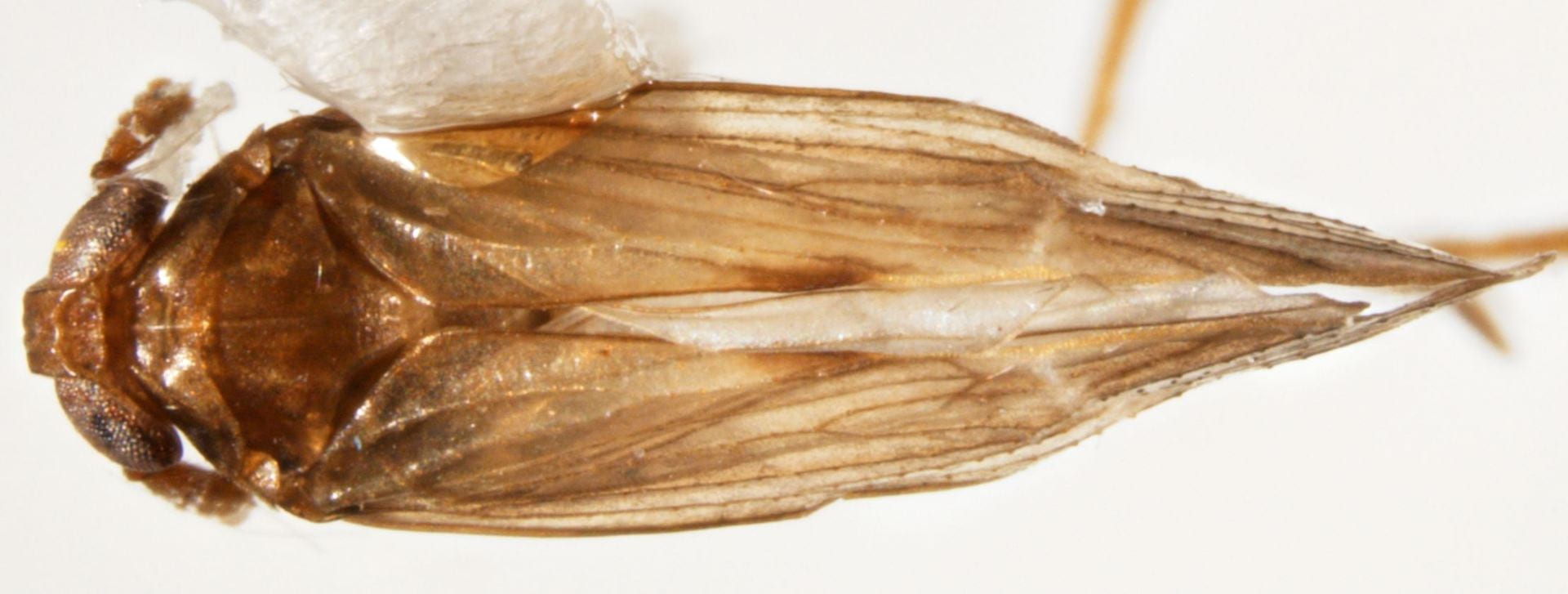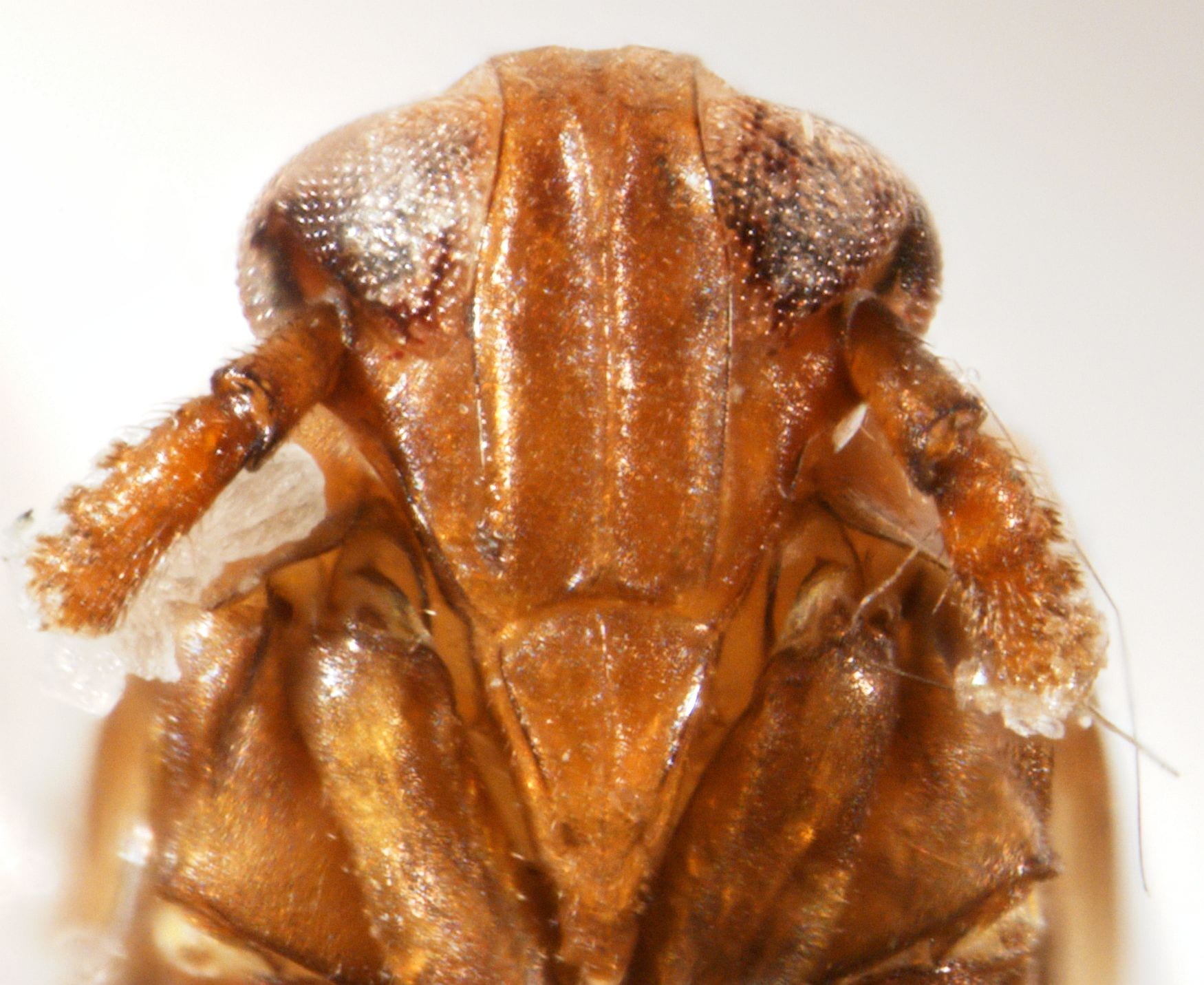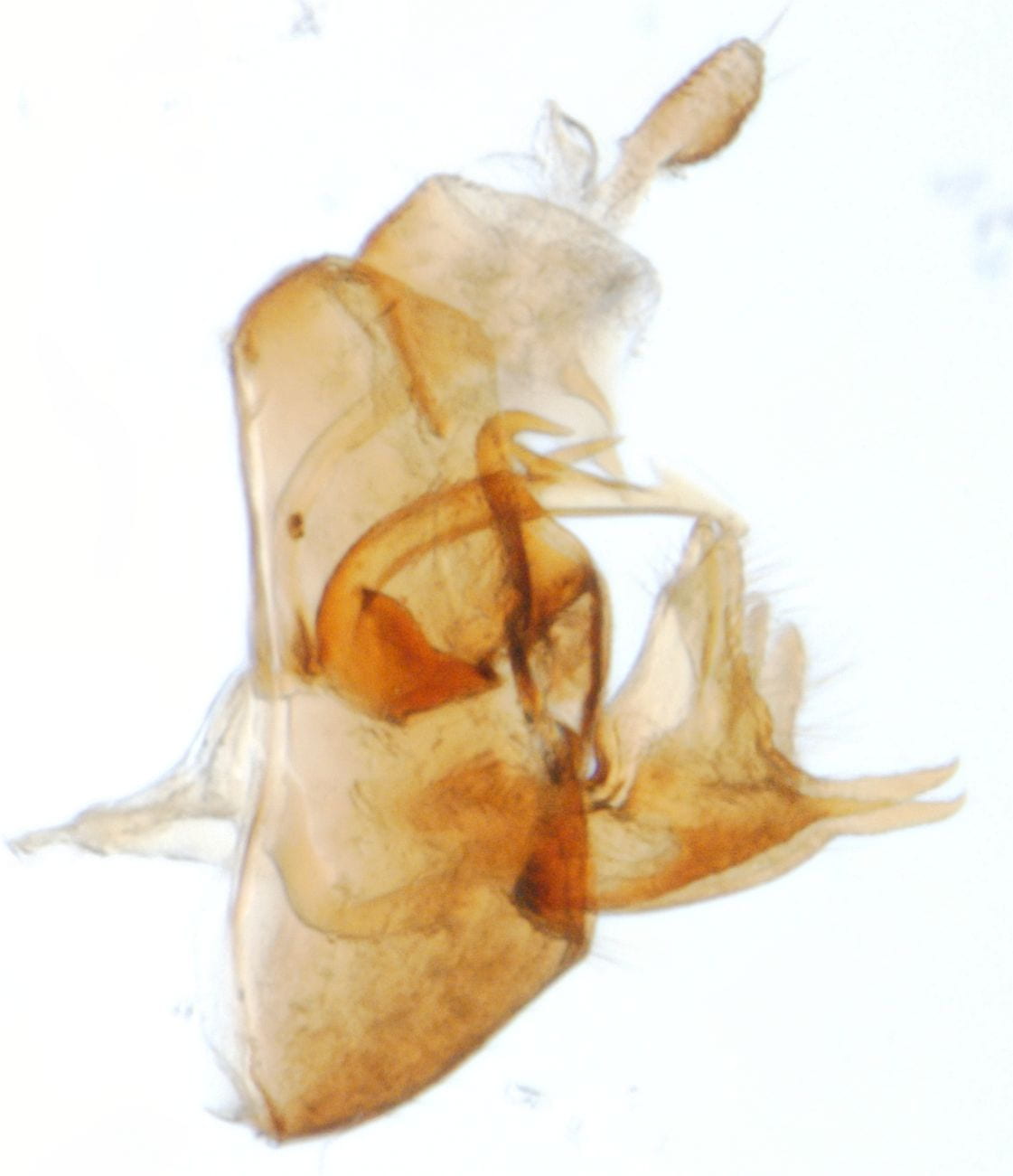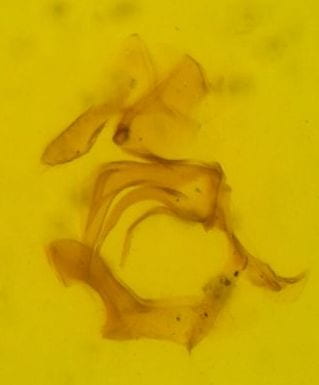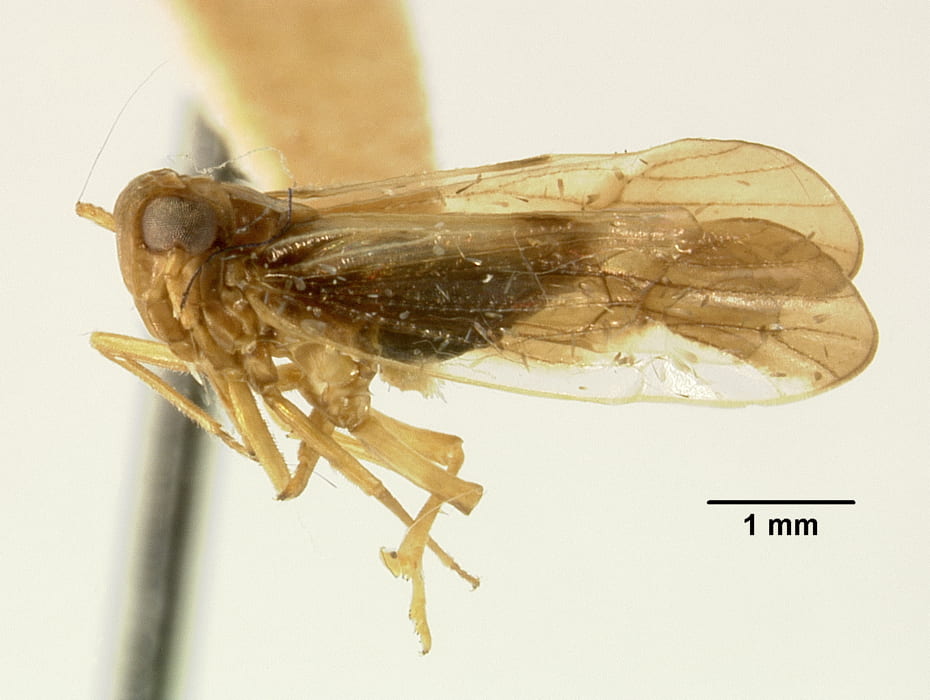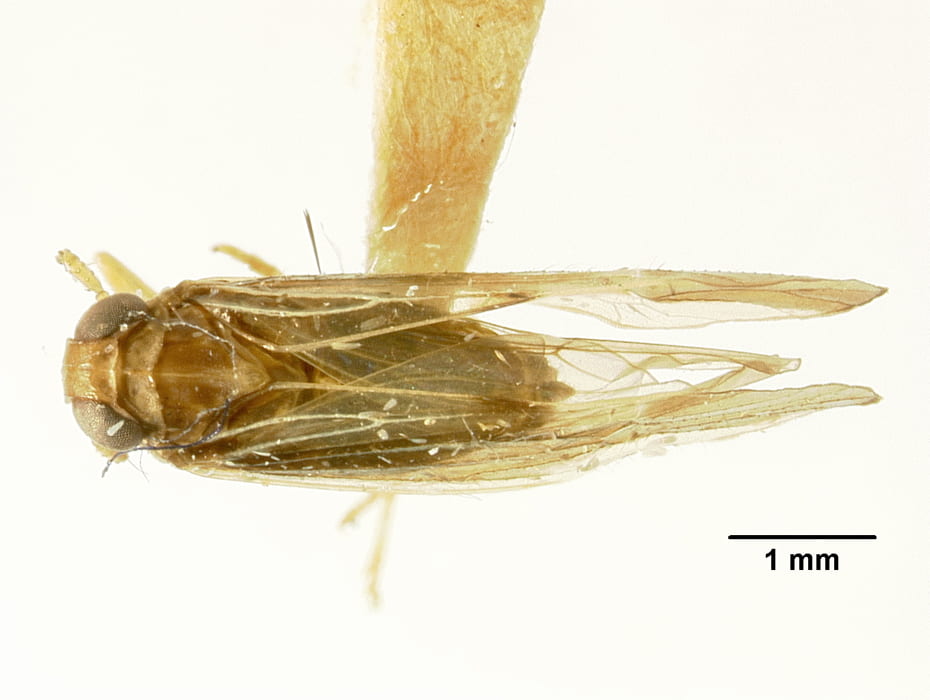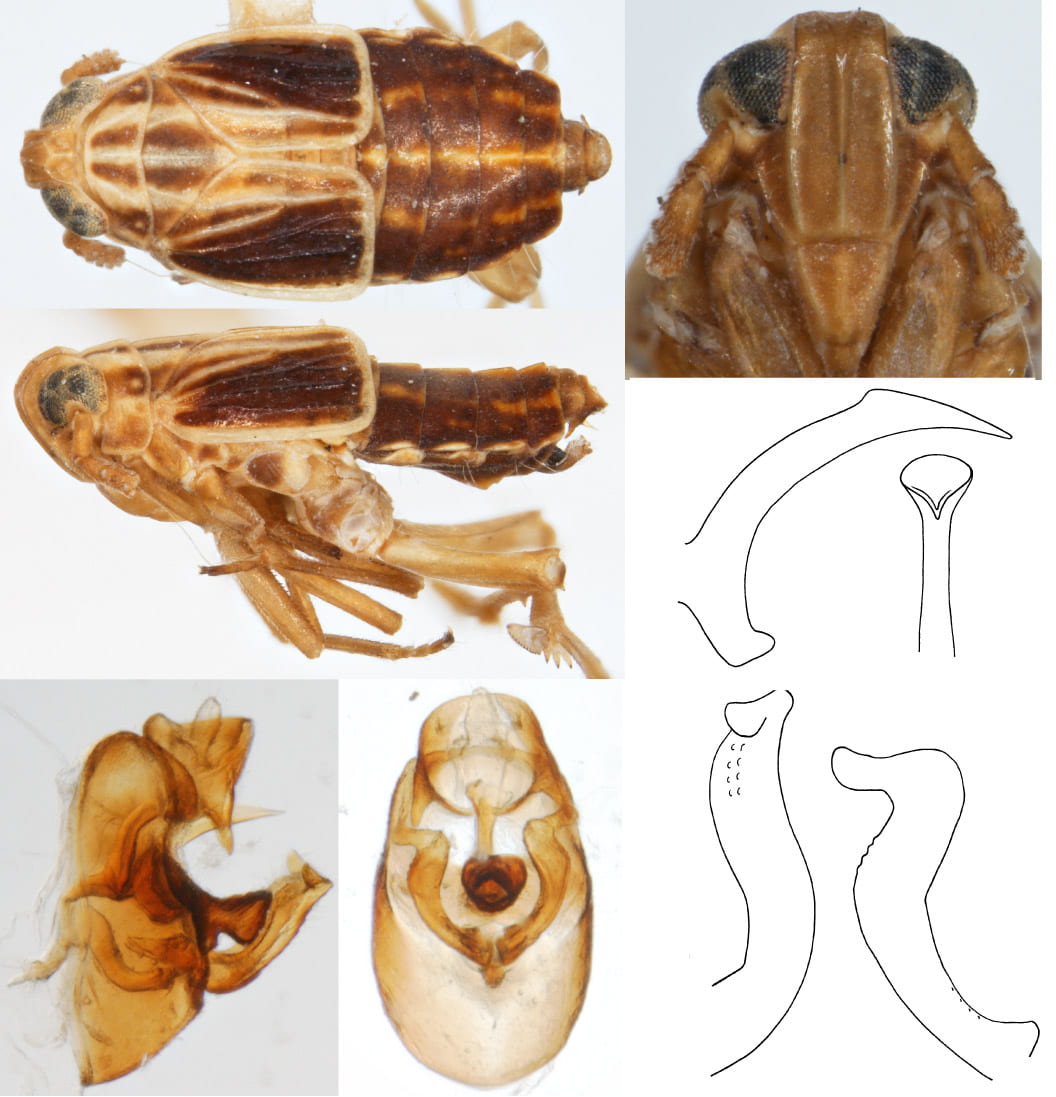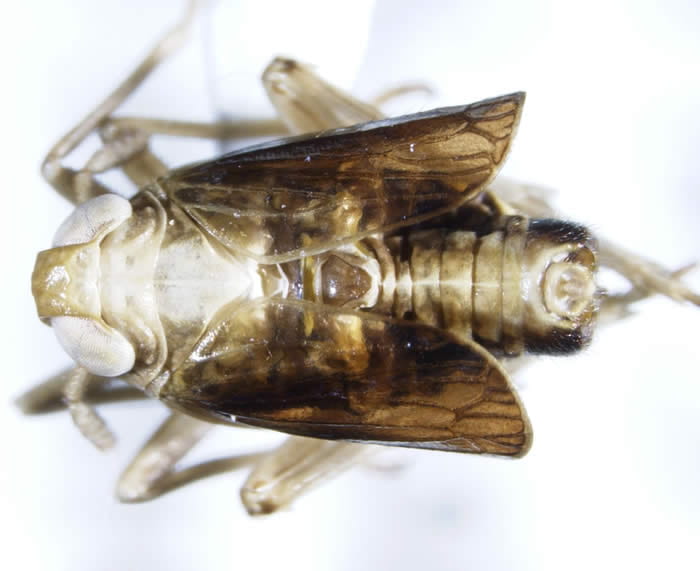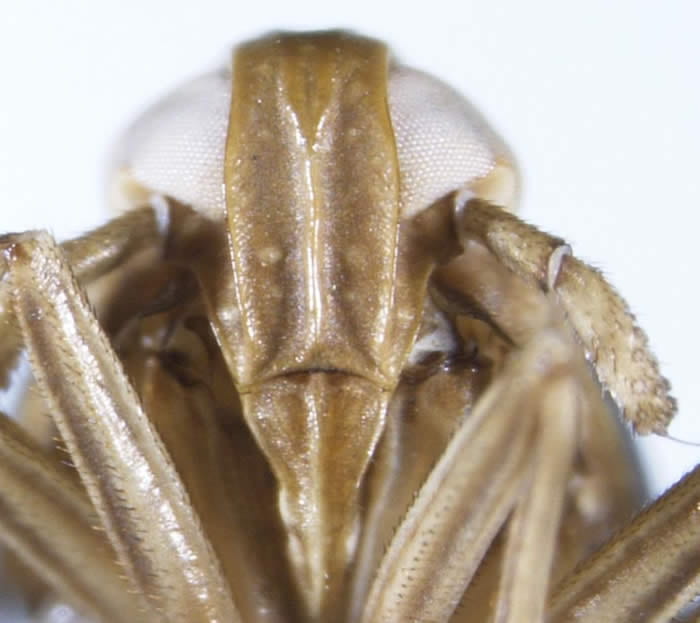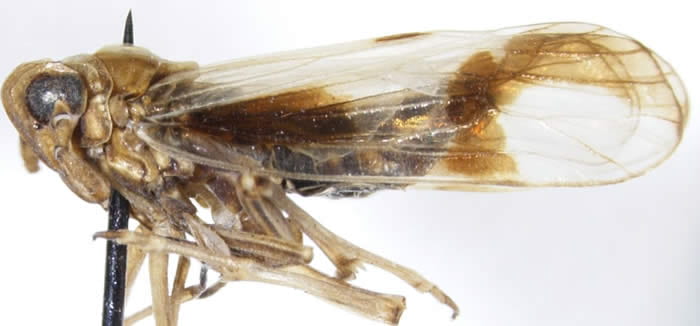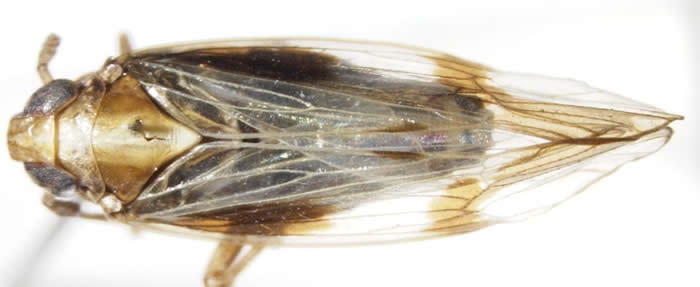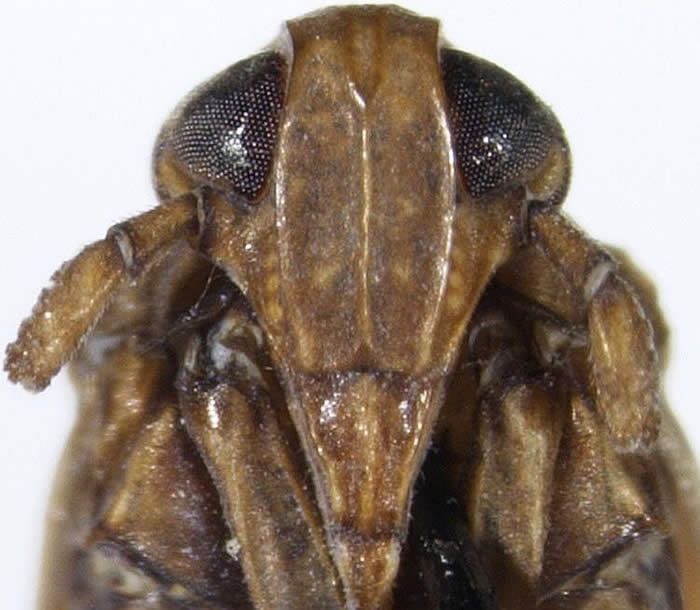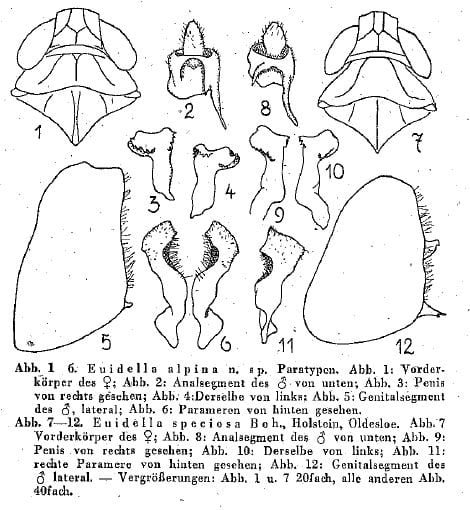[Back to Higher classification of Delphacidae]
[Back to A checklist of New World delphacid species]
Contents
Family Delphacidae Leach, 1815
Subfamily Delphacinae Leach, 1815
Tribe Delphacini Leach, 1815
Genus Euides Fieber, 1866: 519.
Type species (in original combination): Euidella basilinea Germar, 1821.
Synonyms
= Euidella Puton, 1886: 72; syn. by Metcalf (1952: 230).
= Epunka Matsumura 1935b: 77; syn. (with Euidella) by Ishihara 1949: 33.
(synonymy with Toyoides Matsumura, 1935 by Ishihara 1949 subsequently considered error)
Distribution
Widespread as currently defined; mostly Holarctic and Neotropics, but New World taxa probably not monophyletic with Old World taxa.
Recognized species
(distribution information may be incomplete)
A total of 20 species are currently placed in the genus as follows:
New World
1 Euides afasciata (Caldwell, 1951 in Caldwell & Martorell 1951) – Costa Rica, Puerto Rico, St. Lucia
= Euidella afasciata Caldwell, 1951.
= Euides afasciata (Caldwell, 1951); comb. by Metcalf, 1952: 230-231 (by implication).
2 Euides altamazonica (Muir, 1926b) – Ecuador
= Euidella altamazonica Muir, 1926b: 16.
= Euides altamazonica (Muir, 1926b); comb. by Metcalf, 1952: 230-231 (by implication).
3 Euides belemensis (Muir, 1926b) – Brazil
= Pissonotus belemensis Muir, 1926b: 19.
= Euides belemensis (Muir, 1926b); comb. by Bartlett & Deitz, 2000: 146.
4 Euides blairmontensis (Muir, 1926b) – Guiana
= Euidella blairmontensis Muir, 1926b: 16.
= Euides blairmontensis (Muir, 1926b); comb. by Metcalf, 1952: 230-231 (by implication).
5 Euides brazilensis (Muir, 1926b) – Brazil, Ecuador, St. Lucia
= Pissonotus brazilensis Muir, 1926b: 19.
= Euides brazilensis (Muir, 1926b); comb. by Bartlett & Deitz, 2000: 146.
6 Euides elegans (Muir, 1926b) – Ecuador
= Euidella elegans Muir, 1926b: 15.
= Euides elegans (Muir, 1926b); comb. by Metcalf, 1952: 230-231 (by implication).
7 Euides equadorensis (Muir, 1926b) – Ecuador
= Pissonotus equadorensis Muir, 1926b: 19.
= Euides equadorensis (Muir, 1926b); comb. by Bartlett & Deitz, 2000: 146.
8 Euides fasciatella (Osborn, 1935) – Belize, Costa Rica, Mexico Gulf (Veracruz), Nicaragua, Panama, Puerto Rico; USA (Florida)
= Liburniella fasciatella Osborn, 1935.
= Euidella fasciatella (Osborn, 1935); comb. by Caldwell and Martorell, 1951: 190.
= Euides fasciatella (Osborn, 1935); comb. by Metcalf, 1952: 230-231 (by implication).
= Pissonotus striolus Osborn, 1935; syn. by Caldwell and Martorell, 1951: 190.
= Delphacodes cornuta Beamer, 1948b: 96; syn. by Kennedy et al. 2012: 404-405.
9 Euides fucata Berg, 1883: 236 – Argentina
= Euides furcata Berg, 1883: 236; comb. restored by Metcalf, 1952: 230-231 (by implication).
= Megamelus fucatus (Berg, 1883); comb. by Crawford, 1914: 632.
= Euidella furcata (Berg, 1883); comb. by Muir, 1926b: 37.
10 Euides fuscovittata Scott, 1881: 155 – Argentina, Paraguay
= Euides fuscovittata Scott, 1881; comb. restored by Metcalf, 1952: 230-231 (by implication).
= Megamelus fusco-vittata (Scott, 1881); comb. by Crawford, 1914: 632.
= Euidella fusco-vittata (Scott, 1881); comb. by Muir, 1926b: 37.
11 Euides grossa (Van Duzee, 1933) – Costa Rica
= Euidella grossa Van Duzee, 1933.
= Euides grossa (Van Duzee, 1933); comb. by Metcalf, 1952: 230-231 (by implication).
Euides guaduae (Muir, 1926b) – see Muellerianella
Euides magnistyla (Crawford, 1914) – See Pareuidella
12 Euides megalostyla (Muir, 1919: 36) – Guiana
= Pissonotus megalostylus Muir, 1919: 36.
= Euides megalostylus (Muir, 1919); comb. by Bartlett & Deitz, 2000: 146.
Euides triloba (Metcalf, 1923) – See Pareuidella
Euides vanduzeei (Muir and Giffard, 1924) – See Pareuidella
Euides weedi (Van Duzee, 1897) – See Pareuidella
Old World
1 Euides alpina (Wagner, 1948: 72) – Austria, Czech Republic, France, Kazakhstan, Kyrgyzstan, Poland, Russia, Switzerland
2 Euides basilinea (Germar, 1821: 105) – Germany, Japan (Hokkaido, Honshu, Kyushu), Poland, Turkey, Russia, Ukraine
3 Euides bilineata (Matsumura, 1935: 77) – Japan (Hokkaido) [this species missing in FLOW]
4 Euides caspiana (Dlabola, 1961) – Iran, Russia, Turkey
5 Euides horvathi (Lallemand, 1925) – Central Africa, Sudan
= Delphax horvathi Lallemand, 1925
= Euidella horvathi (Lallemand, 1925) by Fennah 1969: 25.
= Euides horvathi (Lallemand, 1925) by implication Metcalf 1952.
6 Euides kashmirensis (Muir, 1922) – India (Darjiling), Pakistan
= Euidella kashmirensis Muir, 1922
= Euides kashmirensis (Muir, 1922) by implication Metcalf 1952.
7 Euides semifuscipennis (Muir, 1926a) – South Africa
= Euidella semifuscipennis Muir, 1926a
= Euides semifuscipennis (Muir, 1926a) by implication Metcalf 1952.
8 Euides speciosa (Boheman, 1845: 163) (replacement name for Delphax basilinea Boheman, 1830 nec Germar – Widespread Europe [but old records may be misidentifications], Russia (Primorye), Turkey, Azerbaijan, Estonia, Kazakhstan, Ukraine; China
= Delphax asiracoides Forel, 1858 synonym of Euides speciosa (Boheman, 1845) by Puton (1899)
= Delphax speciosa Boheman, 1845
= Liburnia speciosa (Boheman, 1845) [Oshanin 1907]
= Euides speciosa (Boheman, 1845)
Bartlett and Deitz (2000) moved several species formerly in Pissonotus to Euides.
This genus is in need of revision. It is not clear whether all of these species belong in Euides. In the analysis of Urban et al, (2010), it was equivocal whether Euides was monophyletic.
Plant associations
Euides speciosa, E. basilinea, E alpina: Common reed (Phragmites).
Euides elegans, E. guaduae: Guadua (Poaceae: Bambuseae) (a bamboo).
Euides speciosa: Arundo donax L.(Giant Cane).
Hosts from Wilson et al. (1994), Gębicki et al. 2013 and FLOW; Plant names from USDA PLANTS or Tropicos.
Economic Importance
Probably limited.
Recognition
Old and New World species are doubtfully congeneric. Old World taxa have unbranched parameres and tend to have asymmetrical processes on segment 10, whereas New World taxa have branched – or complex – parameres and processes on segment 10 are symmetrical or absent. Old World taxa tend to have the median carinae of the frons forked below the fastigium (see photos below), but it is branched much closer to the fastigium in New World species. The main similarities between the genera are relatively large size, a tendency to uniform brown in color with diffuse markings on the forewings. The armature of the diaphragm is quite different between Old and New World forms. New World Euides probably belong in several genera (e.g., Nicetor), some already moved some to Pareuidella (below).
New World
Recently, most Nearctic species have been transferred to the genus Pareuidella (see Kennedy et al. 2012). Pareuidella has a large, bifid, avicephaliform armature of the diaphragm and branched parameres. Tropical species need to be evaluated with respect to their generic placement.
The genus – at least New World members – can be mistaken for Nilaparvata, but lack the teeth on the basitarsus. Most New World species have complex, often branched parameres (Euides fasciatella is an exception, but this species is probably misplaced to genus).
Adults are frequent at lights. Brachypters uncommon for most species, but are sometimes found in series sweeping.
(All photos by Kimberley Shropshire University of Delaware)
New World
Euides afasciata
Euides afasciata (Costa Rica, Heredia)
Euides afasciata (Costa Rica, Heredia)
Euides afasciata
Euides altamazonica
Old World
Euides alpina
Euides alpina and E. speciosa from Wagner (1948)
Online resources
EOL
FLOW
Discover Life
Bugguide (not listed – link is to taxonomy tree)
Gernot Kunz Kunzweb Gallery Costa Rica (nothing in the genus currently photographed)
Gernot Kunz Kunzweb Gallery Europe (nothing in the genus currently photographed)
Leafhopper, Planthopper & Psyllid Vectors of Plant Disease (none listed)
3I Interactive Keys and Taxonomic Databases (Dmitry Dmitriev)
Hemipterans of North Carolina (have correctly placed former Euides in Pareuidella)
Japanese Auchenorrhyncha Image Gallery (none)
DEpository (Metazoa of Germany) (1 species listed)
British Bugs (Euides speciosa)
Molecular resources
Genbank now has several species listed, although several (not all) of these are now in Pareuidella. Bold has records for 4 taxa (plus a ‘sp.’, one of these belongs in Nilaparvata) although only 2 with data.
Selected references
(BHL links incomplete)
Asche, M. 1982. Beitrage zur Delphaciden-Fauna der Turkei (Anatolien) (Homoptera Cicadina Delphacidae). Marburger Entomologische Publikationen 1(7): 71-98. 1982
Asche, M. 1982. Beitrage zur Delphaciden-Fauna Jugoslawiens und Bulgariens (Homoptera Cicadina Delphacidae). Marburger Entomologische Publikationen 1(7): 99-138.
Asche, M. 1982. Beitrage zur Delphaciden-Fauna Ungarns (Homoptera Cicadina Delphacidae). Marburger Entomologische Publikationen 1(7): 139-154.
Asche, M. and R. Remane. 1982. Beitrage zur Delphaciden-Fauna Griechenlands I (Homoptera Cicadina Delphacidae). Marburger Entomologische Publikationen 1(6): 231-290.
Boheman, C. H. 1845. Nya Svenska Homoptera in Ofversigt af Kongliga Svenska Vetenskaps-Akademiens Forhandlingar 1845: 154-164.
Bartlett, C. R. and G. Kunz. 2015. A new genus and species of delphacid planthopper (Hemiptera: Fulgoroidea: Delphacidae) from Central America with a preliminary regional species list. Zootaxa 3946(4):510-518. doi: 10.11646/zootaxa.3946.4.2. [erratum subsequently published Zootaxa 3963 (4): 598–600; http://dx.doi.org/10.11646/zootaxa.3963.4.7]
Bartlett, C.R. and L. L. Deitz. 2000. Revision of the New World delphacid planthopper genus Pissonotus (Hemiptera: Fulgoroidea). Thomas Say Publications in Entomology: Monographs. 234 pp.
Bartlett, C. R., L. B. O’Brien and S. W. Wilson. 2014. A review of the planthoppers (Hemiptera: Fulgoroidea) of the United States. Memoirs of the American Entomological Society 50: 1-287.
Beamer, R. H. 1948. Some new species of Delphacodes (Homoptera: Fulgoridae: Delphacinae), Part IV. Journal of the Kansas Entomological Society 21(3): 96-110.
Berg, C. 1883b. Addenda et emendanda ad Hemiptera Argentina (Continuatio). Anales de la Sociedad Científica Argentina 16: 231-241.
Boheman, C. H. 1845. Nya Svenska Homoptera. Ofversigt af Kongliga Svenska Vetenskaps-Akademiens Förhandlingar 1845: 154-165.
Caldwell, J. S. and L. F. Martorell. 1951 [dated1950]. Review of the Auchenorynchous [sic] Homoptera of Puerto Rico. Part II. The Fulgoroidea except Kinnaridae. Journal of Agriculture of the University of Puerto Rico 34(2): 133-269
Crawford, D. L. 1914. A contribution toward a monograph of the Homopterous insects of the family Delphacidae of North and South America. Proceedings of the United States National Museum 46: 557-640.
D’Urso, V. 1995. Homoptera Auchenorrhyncha. In: Checklist delle specie della Fauna Italiana 42: 1-35
Dlabola, J. 1961. Die Zikaden von Zentralasien, Dagestan und Trankaukasien (Homopt. Auchenorrhyncha). Acta Entomologica Musei Nationalis Pragae 34(587): 241-358.
Dlabola, J. and L. Jankovic. 1981. Drei neue Erythria-Arten und einige Erganzungen der jugoslawischen Zikadenfauna. Bulletin de l’Academie Serbe des Sciences et des Arts Classe des Sciences Mathematiques et Naturelles Sciences Naturelles 75(21): 67-79.
Drosopoulos, S., M. Asche and H. Hoch. 1983. Contribution to the planthopper fauna of Greece. Homoptera, Auchenorrhyncha, Fulgoromorpha, Delphacidae). Annales de l’Institut Phytopathologique Benaki (N.S.) 14: 19-68.
Fennah, R. G. 1959. Delphacidae from the Lesser Antilles (Homoptera: Fulgoroidea). Bulletin of the British Museum (Natural History) Entomology 8: 245-265. pdf
Fennah, R. G. 1969. Delphacidae (Homoptera: Fulgoroidea) from the Sudan Republic. Acta Entomologica Fennica 26: 1-78.
Fieber, F. X. 1866. Grundzüge zur generischen Theilung der Delphacini. Verhandlungen der Kaiserlich-Königlichen Zoologisch-botanischen Gesellschaft in Wien 16: 517-534.
Forel, A. 1858. Notice sur deux insectes nouveaux, Delphax asiracoides et Jassus punctulatus in Bulletins des Seances de la Societe Vaudoise des Sciences Naturelles 5: 251-254. [Delphax asiracoides Forel, 1858]
Gębicki, C., D. Świerczewski and J Szwedo. 2013. Planthoppers and Leafhoppers of Poland (Hemiptera: Fulgoromorpha et Cicadomorpha). Systematics, Check-list, Bionomy. The Monograph. Annals of the Upper Silesian Museum, Entomology 21-22: 1-245.
Germar, E. F. 1821. Bemerkungen über einige Gattungen der Cicadarien. Magazin der Entomologie 4: 1-106.
Hansen, L. O. 2000. Euides speciosa (Boheman, 1845) (Homoptera, Delphacidae) in Norway. Norwegian Journal of Entomology 47(2): 148.
Hayashi, M. and S. Fujinuma. 2016. Part Fulgoromorpha. Pp. 323-355. In: M. Hayashi, M. Tomokuni, K. Yoshizawa, and T. Ishikawa. (eds.). Catalogue of the insects of Japan. Volume 4 Paraneoptera (Psocodea, Thysanoptera, Hemiptera), 4. Editorial Committee of Catalogue of the Insects of Japan, Entomological Society of Japan.
Holzinger, W. E., I. Kammerlander and H. Nickel. 2003. Fulgoromorpha, Cicadomorpha excluding Cicadellidae. Volume 1. The Auchenorrhyncha of Central Europe. Brill Academic Publishing, Leiden, Netherlands.
Ishihara, T. 1949. Revision of the Araeophidae of Japan, Ryukyu Islands and Formosa (Hemiptera). Scientific reports of the Matsuyama Agricultural College 2:1-102.
Jankovic, L. 1975. Recueil des Travaux sur la faune d’Insectes de la France T. I. Odeljenje prirodno-matematickih Nauka Beograd (1975): 85-110.
Jankovic, L. and R. Papovic. 1981. Nove e retke vrste za fauna cikada (Homoptera: Auchenorrhyncha) Jugoslavija I. Glas Srpske akademije nauka i umetnosti in Odeljenje prirodno-matematickih Nauka Beograd 48: 121-134.
Kennedy, A. C., C. R. Bartlett and S. W. Wilson. 2012. An annotated checklist of the delphacid planthoppers (Hemiptera: Delphacidae) of Florida with the description of three new species and the new genus, Meristopsis. Florida Entomologist 95(2): 395-421.
Kunz, G. and W. E. Holzinger. 2018. Remarkable records of nine rare Auchenorrhyncha species from Austria (Hemiptera). Acta Entomologica Slovenica 26(2): 173-180. [Euides alpina]
Lallemand, V. 1925. Hemiptera Homoptera. in Zoological results of the Swedish Expedition to Central Africa 1921. Insecta. Arkiv for Zoologi. Utgifvet af K. Svenska Vetenskaps-akademien. Stockholm 18: 1-8 [6].
Lauterer, P. 1980. New and interesting records of leafhoppers from Czechoslovakia (Homoptera, Auchenorrhyncha). Acta Musei Moraviae 65: 117-140.
Lauterer, P. 1983. Fagocyba cerricola sp. n. and new and interesting records of leafhoppers from Czechoslovakia (Homoptera, Auchenorrhyncha). Acta Musei Moraviae 68: 139-152.
Le Quesne, W. J. 1960. Hemiptera (Fulgoromorpha). Handbooks for the Identification of British Insects II (3): 1-68.
Leach, W. E. 1815a. Entomology. The Edinburg encyclopedia; conducted by David Brewster 9: 57-172. (family Delphacidae here)
Logvinenko, V. N. 1975. Fulgoroidny cicadovy Fulgoroidea. Fauna Ukrainy 20 (2): 1-287 [in Ukrainian].
Mariani, R. and A.M.M. de Remes-Lenicov. 2001. The genus Euides in Argentina (Hemiptera: Fulgoromorpha: Delphacidae). Revista de la Sociedad Entomologica Argentina 60 (1-4): 89-92.
Matsumura, S. 1935b. Supplementary note to the revision of Stenocranus and allied species of Japan-Empire. Insecta Matsumurana 10: 71-78.
Metcalf, Z. P. 1923. A key to the Fulgoridae of Eastern North America with descriptions of new species. Journal of the Elisha Mitchell Scientific Society 38: 139-230.
Metcalf, Z. P. 1943. General Catalogue of the Hemiptera. Fascicle IV, Fulgoroidea, Part 3, Araeopidae (Delphacidae). Smith College, Northhampton, Massachusetts. 552 pp.
Metcalf, Z. P. 1952. New names in the Homoptera. Journal of the Washington Academy of Sciences 42(7): 226-231.
Mozaffarian, F. and M. R. Wilson. 2011. An annotated checklist of the planthoppers of Iran (Hemiptera, Auchenorrhyncha, Fulgoromorpha) with distribution data. ZooKeys 145: 1-57.
Muir, F.A.G. 1919. Some new American Delphacidae. Canadian Entomologist 51: 35-39.
Muir, F.A.G. 1922. New Indian Homoptera. Records of the Indian Museum 24: 343-355.
Muir, F.A.G. 1926a. On some new and little-known Delphacidae from South Africa (Fulgoroidea, Homoptera). Annals and Magazine of Natural History (Ser. 9) 17: 17-35.
Muir, F.A.G. 1926b. Contributions to our knowledge of South American Fulgoroidea (Homoptera). Part I. The Family Delphacidae. Experiment Station of the Hawaiian Sugar Planters’ Association, Entomological Series, Bulletin 18:1-51, plates 1-5.
Muir, F.A.G. and W. M. Giffard. 1924a. Studies in North American Delphacidae. Bulletin of the Hawaiian Sugar Planters Association Division of Entomology 15: 1-53.
Nast, J. 1972. Palaearctic Auchenorrhyncha (Homoptera). An annotated check list in Polish Scientific Publishers, Warszawa, 550 pp.
Nast, J. 1986. Notes on some Auchenorrhyncha (Homoptera), 6-10. Annales Zoologici 40: 297-307.
Nast, J. 1987. The Auchenorrhyncha (Homoptera) of Europe in Annales Zoologici Warszawa 40: 535-661.
Nickel, H. 2003. The Leafhoppers and Planthoppers of Germany (Hemiptera, Auchenorrhyncha): patterns and strategies in a highly diverse group of phytophagous insects in Pensoft Series Faunistica No. 28, Sofia-Moscow, Keltern, 1-460.
Osborn, H. 1935. Insects of Porto Rico and the Virgin Islands. Homoptera (excepting the Sternorhynchi). Scientific Survey of Porto Rico and the Virgin Islands 14: 111-260.
Oshanin, V. T. 1907. Verzeichnis der palaearktischen Hemipteren mit besonderer Berücksichtung ihrer Verteilung im Russischen Reiche. II. Band. Homoptera. II. Lieferung. Annuaire du Musée Zoologique de l’Académie Impériale des Sciences de St.-Pétersbourg. Saint Petersburg 12: 193-384.
Ossiannilsson, F, 1978. The Auchenorrhyncha (Homoptera of Fennoscandia and Denmark. Part 1: Introduction, infraorder Fulgoromorpha in Fauna Entomologica Scandinavica 7 (1): 1-222.
Puton, A. 1886. Homoptera Am. Serv. (Gulaerostria Zett. Fieb.) Sect. 1. Auchenorhyncha Dumér. Cicada Burm. PP. p. 67-89. In: Puton A. 1886 – Catalogue des Hémiptères de la faune paléarctique. Hétéroptères, Cicadines et Psyllides – 3e Edition, 1886.
Puton, A. 1889. Homoptera Am. Serv. (Gulaerostria Zett. Fieb) Sect. 1. Auchenorrhyncha Dumer. Cicadina Burm. Pp 84-109. In: Catalogue des Hemipteres (Heteropteres, Cicadines et Psyllides) de la faune Palearctique. 4e Ed. 1899: 3-121. [Delphax asiracoides Forel, 1858].
Remane, R. and W. Della Giustina. 1987. La faune de France des Delphacidae (Homoptera, Auchenorrhyncha) IV. Recoltes de 1992 in Cahier des Naturalistes, Bulletin 48: 11-24.
Remane, R. and W. Frohlich. 1994. Beitrage zur Chorologie einiger Zikaden-Arten (Homoptera Auchenorrhyncha) in der Westpalaarktis. Marburger Entomologische Publikationen 2(8): 131-188.
Remane, R. and W. Frohlich. 1994. Vorlaufige, kritische Artenliste der im Gebiet der Bundesrepublik Deutschland nachgewiesenen Taxa der Insekten-Gruppe der Zikaden (Homoptera Auchenorrhyncha). Marburger Entomologische Publikationen 2(8): 189-232.
Scott, J. 1881d. On certain South American Delphacidae. Entomologist’s Monthly Magazine 18: 154-156.
Van Duzee, E. P. 1897. A preliminary review of the North American Delphacidae. Bulletin of the Buffalo Society of Natural Sciences. Buffalo, N. Y 5: 225-261.
Van Duzee, E. P. 1933. The Templeton Crocker Expedition of the California Academy of Sciences, 1932, No. 4. Characters of twenty-four new species of Hemiptera from the Galapagos Islands and the coast and islands of Central America and Mexico. Proceedings of the California Academy of Sciences (Ser. 4) 21: 25-40.
Vilbaste, J. 1971. Eesti Tirdid. Homoptera-Cicadinea I. (Tettigometridae, Cixiidae, Delphacidae, Achilidae, Issidae, Cicadidae, Aphrophoridae, Membracidae) in Kirjastus “Valgus”, Tallinn, 1-284.
Wagner, W. 1948. Neue deutsche Homopteren und Bemerkungen über schon bekannte Arten. Verhandlungen des Vereins für Naturwissenschaftliche Heimatforschung zu Hamburg. Hamburg 29: 72-89.
Wagner, W. 1963. Dynamische Taxionomie, angewandt auf die Delphaciden Mitteleuropas in Mitteilungen des Hamburger Zoologischen Museums und Instituts 60: 111-180.
Wilson, S. W., C. Mitter, R. F. Denno and M. R. Wilson. 1994. Evolutionary patterns of host plant use by delphacid planthoppers and their relatives. In: R.F. Denno and T.J. Perfect, (eds.). Planthoppers: Their Ecology and Management. Chapman and Hall, New York. Pp. 7-45 & Appendix.


